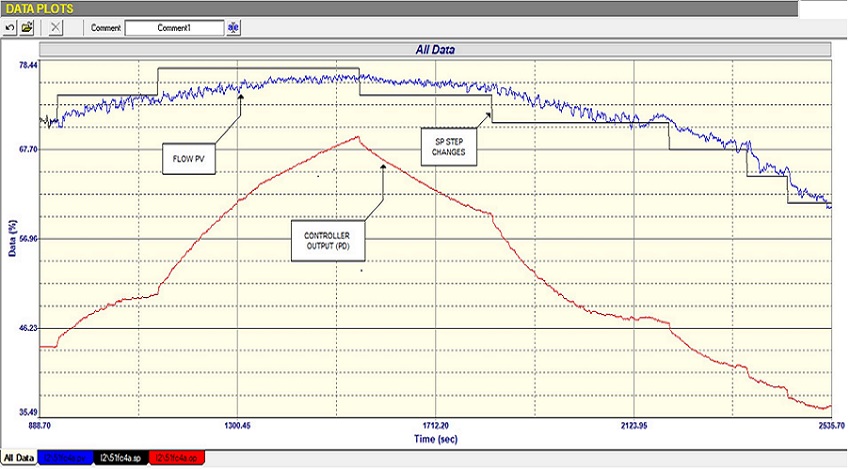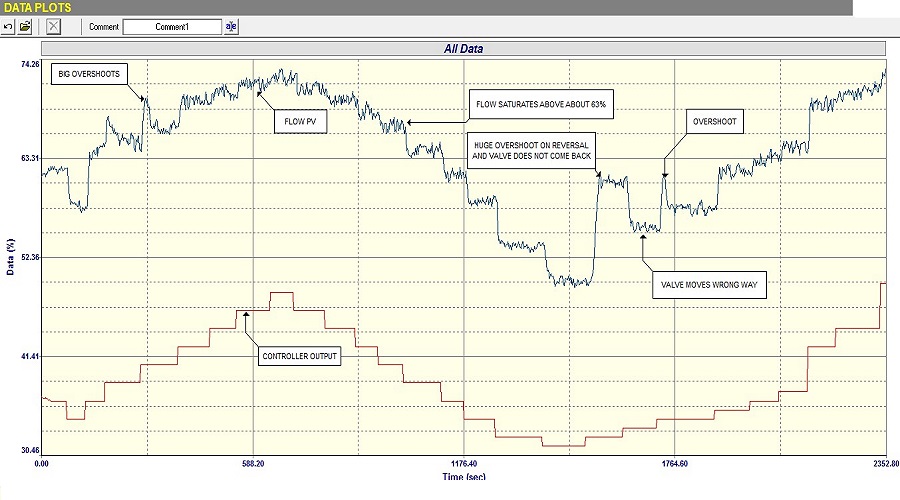Home About us Contact us Protuner Loop Analyser & Tuner Educational PDFs Loop Signatures Case Histories
Michael Brown Control Engineering CC
Practical Process Control Training & Loop Optimisation
CASE HISTORY 191
THE WEAKEST LINK
Many years ago there was a popular quiz programme on TV hosted by Anne Robinson where the players voted in each round as to who was the weakest link. Which is the weakest link in a control loop? The answer without any doubt is that in most cases the final control element is the weakest link.
As mentioned in the preceding article the elements of the control loop consist of the process itself, the transmitter, the controller, and then the final control element.
There are many types of final control elements ranging from simple resistive heating elements through to more sophisticated devices such as variable speed pumps, but in most plants the final element consists of a valve, an actuator, a positioner and an I/P (current to pneumatic) converter.
Pneumatically actuated valves have been in use for well over a century. They are simple and reliable, but are not very sophisticated or “accurate” devices, which is one of the main reasons why a positioner should be always used with this type of actuator.
In general about 80% of all problems are due to faults in the final control element. The problem lies in the fact that valves are mainly mechanical devices, and must face all sorts of possible challenges such as high and possibly varying pressure, friction, abrasion, corrosion, loose linkages, and hysteresis to name a few.
What is the actual purpose of the final control element? Simply put its function is to translate a 0 -100% signal from the controller’s output into an actual physical happening. The controller compares the actual value of the PV (process variable) with the SP (setpoint) and performs a relatively uncomplicated mathematical calculation that outputs a signal (called by us the PD - Process Demand) that demands that the final control element should go to a position where the actual desired quantity of process fluid or substance is fed into the process in order for the PV to reach the SP. As an example, say a heat exchanger is heating a process fluid by injecting steam into the other side of the exchanger, and if the PD is at 55%, then the final control element is required to feed exactly 55% of the total range of the steam flow into the exchanger.
The quicker and more accurately that the final control element complies with that demand will give the best control with least variance.
When a control valve is really bad, the control can become really bad to the point where it just cannot work, and sometimes it becomes absolutely necessary to get the valve fixed, or if this is not possible then it has to be replaced. In spite of this I have often found people still believing that a “miracle” tune will sort out the problem, and I have come across cases where they spend literally days and even weeks, trying different tuning to get it to work, all to no avail.
The example given in this article is of a combustion air flow in a furnace in a petro-chemical refinery. It was vital that the furnace temperature should be kept constant at SP, as quite a few downstream processes were dependent on it. However the temperature was usually never at it’s SP. Investigation revealed that the problem was related to the performance of the combustion air flow, which did not respond quickly enough to deal with load disturbances on the temperature process. This is a rather unusual problem, as airflow is such a fast process compared with temperature, and even rather poor flow control will not usually affect the temperature too much.

Figure 1.
Figure 1 shows a recording of an “As Found” closed loop test on the flow loop where step changes were made on the SP with the original tuning parameters in the controller to judge the control response.
It was found that the tuning was apparently abysmally slow, typically taking over 25 minutes for the process to respond to a 3% change in SP. On discussing this with the C&I staff I was told that they couldn’t get it to work faster as it tended to go into what they described as “crazy cycling” as soon as they tried to speed it up. Normally a flow loop should fully respond to a small SP step like that in a few seconds.
A second interesting thing seen in the test is that on the second upwards step of SP the PD had to move much more than it did on the first step even though the two steps were of equal size. This could indicate several problems including non-linear installed valve characteristics. However on the first reverse step downwards, the PD had to move much less. This is a little puzzling and may also indicate that the valve is very sticky on opening.

Figure 2.
An open loop test was then performed on the flow loop making step changes on the PD, and this shown in Figure 2. This is quite interesting as it shows that there are several serious problems with the valve. These are:
1. When the valve reverses from the closing direction, there are sometimes huge overshoots when it moves in the opening direction again. On some occasions the valve then recovers and moves slowly back down to the correct position. However it sometimes does not do this and sticks in the overshot position.
2. There are some occasions where the valve also has big overshoots on other opening steps.
3. These occurrences make the valve effectively non-repeatable, and will really inhibit good control.
4. There does appear to be some non-linearity in the valve installed characteristics. However of more importance and very seriously, the flow starts saturating above 63%. A subsequent test (not shown here) showed that the maximum flow that could be obtained with the valve fully open was 76%. Under normal operating load conditions the flow SP is just over 70%. Good control in this saturated region is almost impossible. As mentioned above the closed loop test in Figure 1 shows clearly how much the PD has to move on the second upwards SP step to try and get the PV to SP. The reason for this saturation was most likely insufficient upstream pressure in the air stream.
These findings show that good automatic control of the flow will not be possible if the saturation problem is not sorted out, and if the valve is not fixed or replaced to follow the PD properly.
Once again it can be seen how very important it is to thoroughly analyse a loop first to determine if there are any problems, before even thinking of tuning the controller.